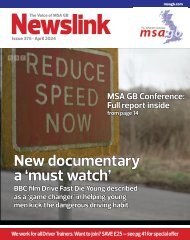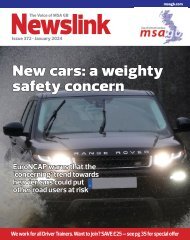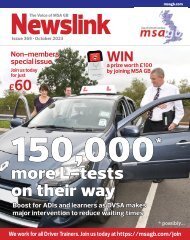Newslink December final
Motor Schools Association members magazine; driver training and testing; road safety
Motor Schools Association members magazine; driver training and testing; road safety
Create successful ePaper yourself
Turn your PDF publications into a flip-book with our unique Google optimized e-Paper software.
Area News<br />
The tech is catching up at pace but<br />
it can’t replace the driver just yet<br />
Janet<br />
Stewart<br />
London & the<br />
South East<br />
Blind spot lights<br />
MSA GB Area 3’s conference and AGM took<br />
place on 12th November, and while it was a<br />
little disappointing that a few people who had<br />
booked on failed to attend, it was still a very<br />
worthwhile and informative event.<br />
It was led by our Chairman, Tom Kwok, with<br />
his usual enthusiasm. He went through the<br />
five top reasons for failure of the Standards<br />
Check. Briefly, they are as follows:<br />
Failure to adapt the lesson plan. When<br />
appropriate the lesson plan needs to be<br />
changed to help the pupil work towards their<br />
learning goals. Commonly, the ADI will try to<br />
stick to the plan, ignoring faults, change the<br />
plan when it is not necessary to do so or not<br />
discuss changing the plan with the pupil.<br />
Inappropriate teaching style. This could be<br />
giving unnecessary briefings, not matching<br />
the Q & A to the pupil’s ability, or failing to<br />
notice that the pupil is not comfortable with<br />
the teaching style.<br />
Failing to encourage the pupil to take<br />
responsibility for their own learning. There<br />
must be a client-centred approach, with the<br />
pupil analysing mistakes with the help of<br />
appropriate Q & A.<br />
The instructor needs to listen carefully to<br />
the pupil’s answers.<br />
Appropriate feedback. The pupil should be<br />
given appropriate and timely feedback, not<br />
ignoring faults that do not relate to the lesson<br />
plan. Where possible feedback should be<br />
given at the time and on the move, not<br />
retrospectively.<br />
Adequate feedback on safety-critical<br />
incidents. The ADI must not overlook or<br />
ignore a safety-critical incident. Such<br />
incidents must be analysed in depth ensuring<br />
the pupil’s understanding.<br />
The situation should be replicated as soon<br />
as possible to ensure learning has taken<br />
place.<br />
After Tom’s presentation, MSA GB National<br />
Chairman Mike Yeomans delivered a very<br />
interesting presentation on Advanced Driver<br />
Assistance Systems (ADAS).<br />
I am sure that I am not alone in having a car<br />
that is capable of doing far more than I am<br />
aware of. Many of us pick up a new car and<br />
don’t go much beyond checking where the<br />
headlamp control (and the high beam) is, and<br />
what sort of speeds the windscreen wipers<br />
can manage.<br />
We then struggle to set up our phones and<br />
spend a frustrating time trying to programme<br />
in our favourite radio stations.<br />
Or is it just me?<br />
One of the most common systems in cars<br />
is a collision avoidance sensor. When the<br />
vehicle is getting too close to, say, the one in<br />
front, many cars will now come up with a<br />
warning on the dashboard, possibly sound an<br />
alarm and then brake on the driver’s behalf.<br />
This is really helpful in unexpected situations<br />
but can be very disconcerting for a learner<br />
who has not been told about this in advance.<br />
Adaptive cruise control is a bit ‘marmite’. If<br />
the car has to slow down for any reason the<br />
car will then accelerate back up to the set<br />
speed and it will often do this very quickly,<br />
taking the driver unawares.<br />
However, it will enable the driver to keep to<br />
a safe distance on a motorway and, coupled<br />
with lane keep assist, is leading to a reduction<br />
in rear end shunts.<br />
Some cars now have a blind spot light in<br />
the corner of the door mirror. This will<br />
activate when another vehicle is in the blind<br />
spot, giving a warning of encroachment that<br />
the driver may not have seen. This is<br />
particularly useful at night when the light<br />
coming on is more noticeable. One of the<br />
latest systems is fatigue detection. A sensor<br />
notices when the driver’s eyes seem to be<br />
drooping or lacking movement, indicating<br />
lack of attention.<br />
Park assist is now quite common and can,<br />
on some vehicles, be activated by phone.<br />
Auto-park is the only adaptation not<br />
currently permitted on driving tests. We are<br />
also moving towards interactive traffic lights;<br />
connectivity will tell the car that the lights are<br />
going to change.<br />
It should be borne in mind that these<br />
systems act as a ‘smart co-pilot’,<br />
complementing but are not replacing the<br />
skills of the driver. From April 2024 all<br />
European cars will have to have Intelligent<br />
32 NEWSLINK n DECEMBER 2023
















